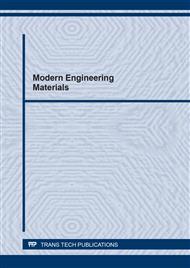p.103
p.111
p.117
p.129
p.137
p.145
p.157
p.171
p.179
Development of Characteristics and Thermal Properties of Ash Celadon Glazes in Thailand
Abstract:
In this paper, we will study the development and comparison of characteristics and thermal properties of original celadon glazes and celadon glazes developed by adding black rice husk ash, Using Mae Rim black clay in Chiang Mai Province as raw material for the original celadon glaze (CG), including clay in the rice paddies, Kha wood ash and mixed wood ash. The raw materials for the development of celadon glazes formula were 14BR, 15BR, 20BR, 21BR, 27BR and 28BR, respectively. Using a triangular phase diagram system, Mae Taeng clay (MT), Kha wood ash (KWA) and black rice husk ash (BR) were used in the ratios of 40, 50, 60 and 70 wt.%, and using the red clay from Doi Saket, Chiang Mai as a coloring agent. Subsequently, the raw materials are ground and mixed to form a coating. Coated onto Mae Rim black clay test specimens. and fire the test specimen at 1250 °C in a reducing atmosphere. After that, the characteristics of the glazes after firing were tested, including crack, melt, flow, color appearance, and chemical composition. Thermal properties tests include the coefficient of thermal expansion and thermal shock resistance in temperature. The results showed that by comparing the original formula celadon glazes (CG) with the celadon glazes formula developed by adding black rice husk ash. crazing were reduced when adding more black rice husk ash. All formulations were melted at 1250 °C due to their CaO content of 55.0, 47.6, 41.0, 51.0, 47.9, 47.7 and 43.0 % respectively. From the chemical composition analysis with XRF, celadon glazes after firing in all formulas did not see any flow due to the content of SiO2 being 28.0, 28.8, 35.4, 26.7, 28.3, 27.9 and 31.1% respectively. The appearance of glazes after firing was more greenish-yellow when rice husk ash was added when using a color analyzer. Because the amount of Fe2O3 up to 4.6, 9.3, 10.4, 8.2, 9.1, 5.9 and 6.0% respectively from Mae Taeng clay and Doi Saket clay. The chemical composition of celadon glaze consists of CaO as the main component, followed by SiO2 and Fe2O3. The important thing is the chemical composition of the glazes was not found with lead and cadmium. The thermal expansion coefficient of celadon glazes at 25-1250°C decreased when adding more black rice husk ash. Finally, the percentage of strength loss after thermal shock temperature change was CG ˃ 20BR ˃ 21BR ˃ 27BR ˃ 28BR ˃ 14BR ˃ 15BR, respectively, using the Celadon Pottery Community Standards Test. (MorChor. 245/2013).
Info:
Periodical:
Pages:
137-141
Citation:
Online since:
April 2022
Authors:
Keywords:
Price:
Сopyright:
© 2022 Trans Tech Publications Ltd. All Rights Reserved
Share:
Citation:


